Bern
![]()
This article is about the city in the eponymous canton of Bern, for other meanings see Bern (disambiguation).
Bern ![]()
![]() bɛrn] (French Berne [bɛʁn], Italian Berna [ˈbɛrna], Rhaeto-Romanic
bɛrn] (French Berne [bɛʁn], Italian Berna [ˈbɛrna], Rhaeto-Romanic![]() , Bärn [b̥æːrn]) is a political municipality in Switzerland and, as a federal city, its de facto capital (see also Capital of Switzerland question). Bern is the capital of the canton of the same name and lies in the Bern-Mittelland administrative district of that canton. The city is not only the seat of the municipal and cantonal, but as a federal city also of the federal administration and thus the largest administrative center in Switzerland.
, Bärn [b̥æːrn]) is a political municipality in Switzerland and, as a federal city, its de facto capital (see also Capital of Switzerland question). Bern is the capital of the canton of the same name and lies in the Bern-Mittelland administrative district of that canton. The city is not only the seat of the municipal and cantonal, but as a federal city also of the federal administration and thus the largest administrative center in Switzerland.
The Zähringerstadt, founded in 1191, has been partially preserved in its original form with its characteristic arcades. A Free Imperial City since 1218, Bern joined the Swiss Confederation in 1353 and developed into the largest city-state north of the Alps by the 16th century. In 1983, Bern's Old Town was inscribed on the UNESCO World Heritage List.
The city of Bern has a total population of 143,278 (as of December 31, 2019). After Zurich, Geneva, Basel and Lausanne, and ahead of Winterthur, it is one of the most populous municipalities with over 100,000 inhabitants in Switzerland.
For years, Bern has been listed with Zurich and Geneva as one of the cities with the highest cost of living in the world.
In the agglomeration of Bern, which includes 70 municipalities, the permanent resident population is 419,983 people (as of 2018).
The city of Bern is the center of the Bern-Mittelland administrative region and the Bern-Mittelland regional conference with its sub-conference on the Bern economic region. For some time now, there have also been efforts to position the city and the agglomeration even more clearly as the capital region of Switzerland. Members there are the cantons of Bern, Fribourg, Valais, Neuchâtel and Solothurn as well as cities, municipalities and regional organizations.
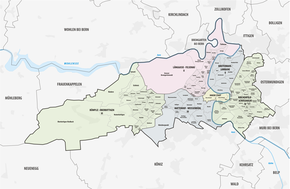
Common quarters of Bern
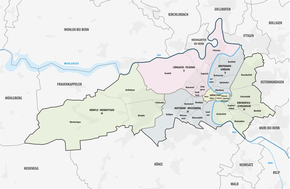
Statistical districts of Bern

City of Bern
Geography
The city of Bern is situated at 542 m above sea level in the Swiss Mittelland on both sides of the Aare between the local mountain Gurten in the south and the Bantiger in the east. The Aare flows around the old town of Bern with a loop extending to the east (Aareschlaufe). In the area of the old town and to the north of it, it has sunk about 30 to 50 meters deep into the surroundings with a narrow valley.
Topography
Topographically, the municipal territory of the city of Bern is located in the Swiss Plateau and covers an area of 51.60 square kilometers. It extends in a west-east direction over a length of 15 kilometers, while the average width in a north-south direction is about four kilometers. The old observatory (now demolished and replaced by the Institute of Exact Sciences) is the historical center of the national survey of Switzerland and bears the Swiss national coordinates 600'000/200'000.
The landscape-forming factor is the Aare, which flows into the area from the southeast. The Aare valley, which is still wide just outside the municipal floor, narrows visibly and forms a narrow valley notch from the beginning of the river loop around the old town. The valley floor here lies at around 500 m above sea level. After only a short, straight course in a northerly direction below the old town arch, the river bends around the plateau of Tiefenau and Felsenau. Approximately from the mouth of the little river Worble below Tiefenau, the Aare marks the northern boundary of the municipality. It continues to flow westward, still cut into the surrounding plateau. Its course widens due to the damming of Lake Wohlen.
To the east of the Aare is a plateau at an average altitude of 550 meters above sea level. It is largely populated and has extensive areas of both commercial and industrial use, sports facilities (Wankdorf stadium) and traffic areas. Individual hills such as the Schärmenwald (588 m above sea level) and the Schosshalde (590 m above sea level) are covered with forest. In the far east, the urban area extends to the foot of the Ostermundigenberg. The part of the Bern plateau to the west of the Aare also reaches an altitude of around 550 m above sea level. The Bremgartenwald forest, which covers about 5 square kilometers, adjoins the settlement area to the northwest. It slopes down to the Aare valley in the north with a steep step and is subdivided by several short erosion valleys. Between the district of Bümpliz and the suburban municipality of Köniz is the Könizbergwald, a wooded ridge of hills, at 674 meters above sea level the highest elevation in the municipal area of the city.
The long western tip of the municipal area is rural. The terrain shows various hollows, former moorland depressions (for example the Bottigenmoos) and hills, but overall is only slightly relieved. It is drained to the Aare by the Gäbelbach, whose valley is up to 80 meters deep in the lower part. In addition to smaller settlements, there are extensive arable and meadow areas, which lead to the south to the large forest area of the Forst (up to 660 m above sea level).
Of the total area of the city of Bern, 44.2 percent was designated as settlement, industrial, commercial and traffic area, 33.5 percent as forest and copses and 20.2 percent as agricultural area in the 2006 survey. The remaining 2.1 percent is classified as unproductive land.
Geology
Geologically, Bern lies in the Molasse Basin of the Swiss Plateau. The basin was filled in the course of the Tertiary with the erosion debris of the emerging Alps, whereby the sediments can be divided into different layers.
The bedrock in the Bern area consists of sediments of the Lower Freshwater Molasse, which were deposited in the Aquitanium in the period about 23 to 20 million years ago. The so-called Gümmenen strata contain relatively soft sandstones of different grain size with interbedded, often reddish marls. These sediments, whose dimension in the area of Bern is estimated at about 800 meters, were transported here by rivers from the Alps. Major depositional and rearrangement events took place especially during floods and inundations, which explains the rapid horizontal and vertical change of the individual layers. In the very south of the area, the Gümmenen strata are overlain by the Sense strata of Upper Marine Molasse deposited in the Burdigalian 20 to 16 million years ago. This solid, benched sandstone contains glauconite and is widely used as a building stone in the old town of Bern.
The surface forms in the urban area of Bern are characterized by glacial deposits, which reach an extension of a few meters to over 50 meters. During the ice ages, the Aare glacier advanced far beyond Bern into the Central Plateau and merged here with the Rhone glacier. While only a few witnesses of the older glacier advances are preserved on the surface (in particular old moraines in the Aare valley), the plateaus on both sides of the Aare valley in the area of the city of Bern, the Bremgarten forest as well as the area of the forest consist of gravels. These were deposited during the advance and retreat of the Würm Ice Age Aare Glacier, which reached its maximum extent about 20,000 years ago. In contrast to the Nagelfluh, the gravels show only weakly consolidated layers of gravel containing blocks of flysch sandstones and siliceous limestones of the Bernese Alps up to 20 centimeters in size. In between are sandy layers. Therefore, gravel mining is carried out in numerous places in the Bern region. Remains of a terminal moraine formed during the last retreat of the Aare glacier, the so-called Bern stage, form a series of hills ranging from Steinhölzli to Veielihubel, Falkenhöhe near the university, Rosengarten and Schönberg to Schosshalde.
Climate
The city of Bern is located in the temperate climate zone with deciduous forests (effective climate classification Cfb). The individual seasons are pronounced, as in the whole of Switzerland north of the Alps. On average, it rains about 90 mm per month and 1060 mm per year. With about 120 mm per month, it rains about twice as much in summer as in winter due to the mostly convective precipitation; on average, more than one millimeter of precipitation can be expected on 124 days per year. The measuring station of the Federal Office of Meteorology and Climatology (MeteoSwiss) is located in the suburb of Zollikofen, at 553 meters above sea level. , about 5 km north of the city center (as the crow flies).
The annual mean temperature is 8.8 °C, with the coldest monthly mean temperatures measured in January at -0.4 °C and the warmest in July at 18.3 °C. On average, about 104 frost days and 23 ice days are to be expected here. Summer days average around 42 per year, while there are usually 6.3 heat days; in particularly hot summers, it can get around 37 °C.
With an average of 1683 hours of sunshine per year, Bern has a relatively high sunshine rate compared to other measuring stations in the Central Plateau of German-speaking Switzerland. The highest value for the average sunshine duration in the month of January was reached in 2020 with 137.4 hours. This broke the long-term record of 1949 with 103.7 hours by far.
The mean wind speed in the measurement period from 1981 to 2000 was 1.6 m/s, with winds from southwesterly and northeasterly directions (bise) predominating. The highest mean wind speeds are reached during westerly wind conditions.
| Bern 1981-2010 | ||||||||||||||||||||||||||||||||||||||||||||||||
| Climate diagram | ||||||||||||||||||||||||||||||||||||||||||||||||
| ||||||||||||||||||||||||||||||||||||||||||||||||
| Monthly average temperatures and precipitation for Bern 1981-2010
Source: MeteoSwiss | |||||||||||||||||||||||||||||||||||||||||||||||||||||||||||||||||||||||||||||||||||||||||||||||||||||||||||||||||||||||||||||||||||||||||||||||||||||||||||||||||||||||||||||||||||||||||||||||||||||||||||||||||||||||||||||||||||||||||||||||||||||||||||||||||||||||||||
City structure and neighboring municipalities
→ Main article: City division of the city of Bern
The urban area of Bern is divided into six districts, which in turn are subdivided into a total of 32 statistical districts. Below that, there is the level of 114 common quarters.
The core of the settlement area is the old town of Bern, called the Inner City district. This has been divided into five quarters designated by color since the Napoleonic occupation of 1798. The city center is bordered to the northwest and north by the Länggasse-Felsenau district, to the north by Breitenrain-Lorraine, to the east and southeast by Kirchenfeld-Schosshalde, and to the southwest and northeast by Mattenhof-Weissenbühl. Only the district of Bümpliz-Oberbottigen lies further to the west.
The following table compares the city districts and statistical districts of Bern. All population figures for the resident population within Bern are provided by Statistik Stadt Bern, the responsible specialized unit. They include all persons registered in the city of Bern by means of Heimatschein, Heimatausweis or Ausländerausweis (including secondary residence and non-permanent resident population). This difference to usually used figures of the BfS is justified by the fact that all persons have to be considered for the planning of the infrastructure of Bern.
| District | Statistical districts | Area | One resident | Proportion of foreigners |
| I Inner city | Yellow quarter - Green quarter - Red quarter - Black quarter (mat) - White quarter | 84,2 | 4'688 | 20,3 % |
| II Länggasse-Felsenau | Engeried - Felsenau - Länggasse - Muesmatt - Neufeld - Stadtbach | 1139,9 | 19'761 | 19,2 % |
| III Mattenhof-Weissenbühl | Holligen - Mattenhof - Monbijou - Sandrain - Weissenbühl - Weissenstein | 692,8 | 31'350 | 23,1 % |
| IV Kirchenfeld-Schosshalde | Beundenfeld - Brunnadern - Gryphenhübeli - Kirchenfeld - Murifeld - Schosshalde | 844,0 | 27'130 | 20,7 % |
| V Breitenrain-Lorraine | Altenberg - Breitenrain - Breitfeld - Lorraine - Spitalacker | 384,0 | 25'706 | 18,4 % |
| VI Bümpliz-Oberbottigen | Bethlehem - Bümpliz - Oberbottigen - Stöckacker | 2022,9 | 34'643 | 35,1 % |
| Bern Total | 5161,8 | 143'278 | 24,1 % |
Bern borders eleven municipalities: Bremgarten bei Bern, Kirchlindach, Wohlen bei Bern and Zollikofen to the north, Ittigen, Muri bei Bern and Ostermundigen to the east, Köniz to the south and Frauenkappelen, Mühleberg and Neuenegg to the west.
Agglomeration and possible mergers
The population of the entire agglomeration of Bern, which includes 70 municipalities, is reported at 419,983 people in 2018. Excluding the city of Bern, the figure is 286,100 people. In the so-called agglomeration main core (14 municipalities) live 262,943 people, without the city of Bern 129,060 people, in the agglomeration belt and secondary core 157,040 people. The Regional Conference Bern-Mittelland counts 414'658 persons, without the city of Bern 280'775 persons. Since 1930, the area of the agglomeration has expanded several times. The administrative district of Bern-Mittelland is not significantly larger.
The municipalities of Bolligen, Bremgarten bei Bern, Frauenkappelen, Kehrsatz and Ostermundigen examined the opportunities and risks of a merger with Bern as part of a feasibility study Cooperation Bern. Bolligen does not border on Bern, but would then have been connected to Bern via Ostermundigen. If the outcome is positive, referendums are planned for mid-2023 and, if accepted, the first joint elections for fall 2024. With the exception of Ostermundigen, all municipalities have spoken out against merger negotiations.
Other localities named Bern
Several towns in the United States of America were named after the city of Bern. The best known is the port city of New Bern in North Carolina, founded in 1710 by the Bernese patrician Christoph von Graffenried, where Pepsi-Cola was invented. In addition, in the states of Idaho (Berne, Idaho), California (Berne, California), Kansas (Berne, Kansas), Pennsylvania and Wisconsin (Berne, Wisconsin) each has a town with the name Berne - in the American television series "Jericho" New Berne, Kansas - in Indiana and New York Berne spelled. Italian Verona was also called Bern in German outdated and vice versa Bern Verona in Üechtland.

Common quarters of Bern and neighboring municipalities
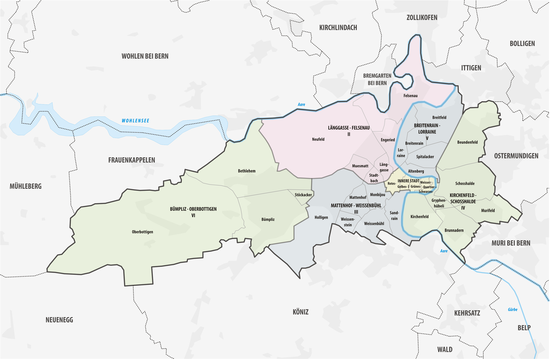
Statistical districts of Bern and neighboring municipalities
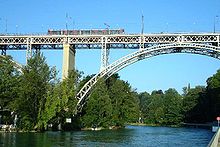
Church Field Bridge
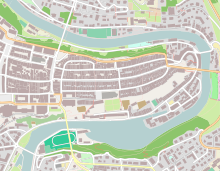
The Aare Loop

Aerial view Bern, looking southeast, July 2009

Untertor bridge in Bern

Kramgasse in Bern
Population
Population development
See also: Key figures on population for the city districts and statistical districts
The city of Bern owes its growth primarily to immigration from the countryside.
At the time of its foundation at the end of the 12th century, the town had about 500 inhabitants, 100 years later it was probably already 3000. In the following centuries, despite the rampant plague, the population increased steadily and by the middle of the 15th century had grown to 5000. After a decline in the second half of the 15th century, the population continued to grow steadily in the following centuries. In 1764, when the first population census was taken, there were 11,000 inhabitants, by 1800 there were probably already 12,000, and by 1850 there were almost 30,000, without the city having grown significantly or fundamentally changing its appearance.
In the second half of the 19th century, the population doubled and exceeded the 100,000 mark in 1920. Population growth continued until the 1960s, reaching a temporary peak of over 165,000 inhabitants in 1963 and then declining.
After a longer period with partly large out-migration surpluses, there have been migration gains for persons again since the year 2000. The migration balance of families continues to be negative. It is mainly younger individuals (education, work) who move to the city. Many of them marry later and move as families to the surrounding area of the city of Bern. Since the mid-1970s, the number of people moving in and out of the city has been significantly lower than in previous years. In the past, the migration movements were strongly influenced by seasonal workers moving in and out of the city.
At the end of December 2019, the population was 143,278, an increase of 0.6% compared to 2018. 75.9% were Swiss and 24.1% were foreigners.
Population composition
| Nationality | Share |
| Switzerland | 68,2 % |
| Germany | 5,9 % |
| Italy | 3,8 % |
| Spain | 1,8 % |
| Portugal | 1,4 % |
| North Macedonia | 1,1 % |
| Kosovo | 1,1 % |
| Turkey | 1,1 % |
| France | 0,8 % |
| Eritrea | 0,8 % |
| Sri Lanka | 0,7 % |
| Serbia | 0,6 % |
| China People's Republic of | 0,6 % |
| Austria | 0,6 % |
| remaining | 11,3 % |
143,278 (75.9 percent) of the inhabitants of the city of Bern are Swiss citizens, 34,540 (24.1 percent) are foreign citizens. The largest groups of foreigners come from Germany (6387 persons), Italy (4168), Spain (1940), Portugal (1508), Northern Macedonia (1231), Kosovo (1206) and Turkey (1155).
Bern has a female surplus; 52 percent (74,511) are women, 48 percent (68,767) men, but there are striking differences between the Swiss and foreign resident populations. For every 100 Swiss women, there are about 87 Swiss, but for every 100 foreigners, there are about 109 foreigners.
The average age of Bern's population decreased in the 2000s, reaching 41 years and nine months in 2008. Among the Swiss, men are younger than women, by an average of 1616 days in 2008 with a decreasing trend, while the reverse is true for the foreign resident population. Men are older than women, by 477 days in 2008, and the average age is increasing for both. In 2008, it was 36.05 years for men and 34.75 years for women.
The number of single people in the total population increased in 2015 to 53.2 percent of women and 57.1 percent of men. The number of married people is still 29.5 percent of women and 33.6 percent of men. Divorced are 8.5 percent of the total population.
Citizenship
The city of Bern is a two-part civic community. In addition to the residents' municipality, which was created in 1832, the Burgergemeinde Bern exists with 13 societies and guilds as a staff municipality under public law with 18,266 members as of the end of 2015.
Languages
The official and written language in the city of Bern is German. In the federal census of 2000, a good 81 percent of Bern's resident population gave German as their main language, with French and Italian each accounting for just under four percent.
The spoken colloquial language is Bernese German, a High Alemannic dialect. The dialect of the city of Berne exhibits a social division that can hardly be observed in other Swiss cities, but it is also less pronounced today than it was in the middle of the 20th century. One of the most striking features of the "elevated" dialect of the city of Bern is the absence of the vocalized "L": for example, milk is called "Milch" and not "Miuch", I wanted "i ha welle" and not "i ha wöue". Certain peculiarities characterize exclusively the language of the Bernese patriciate, but they are becoming more and more lost. An additional peculiarity of Bernese German is the adoption of some words from the former lower class district of Matte, which had a constructed secret language with Mattenenglisch, which is still cultivated folkloristically today. The frequently used words "jiu/ieu" for "ja" or "Giel/Gieu" for "Bub/Knabe" originate from Mattebern German.
Religious communities and denominations
| City of Berne population by state-recognized religion/denomination - December 31, 2013 | |||
| Religion/denomination | Swiss | Other nationality | Total population |
| evangelical reformed | 50,5 % | 5,5 % | 39,8 % |
| Roman Catholic | 19,0 % | 34,1 % | 22,5 % |
| evangelical lutheran | 0,2 % | 1,8 % | 0,5 % |
| christian catholic | 0,3 % | 0,5 % | 0,3 % |
| israelite | 0,2 % | 0,1 % | 0,2 % |
The city and canton of Bern recognize state-recognized religions and denominations: The Evangelical Reformed, the Evangelical Lutheran, the Roman Catholic and the Christian Catholic denominations as well as the Israelite religious affiliation.
The majority of the population of the city of Berne belongs to a religious community. In the 2000 census, only 16,363 (12.7%) people described themselves as non-denominational, while 7855 did not specify. In 2012, according to the Federal Statistical Office, 25% of the over-15s were already non-denominational.
According to the 2000 census, the following percentages were found for the Swiss resident population: Protestant Reformed Church just under 59 percent, Roman Catholic Church just under 20 percent, no affiliation a good 13 percent and no indication a good 4 percent. Among foreigners, the Roman Catholic Church leads with 43 percent, followed by the Islamic communities with just under 15 percent, the Protestant Reformed Church with over 5 percent and the Christian Orthodox churches with just under 5 percent. Almost 11 percent of the foreign population does not belong to any religious community, and 13 percent did not give any information on this question.
Between 1999 and 2009, the Protestant Reformed Church lost its majority: While 52% of the total population of the city of Bern were members of this church in 1999, the figure was 44% in 2009 and 39.8% in 2013. The number of Catholics has also decreased: from 27% in 1999 to 24% in 2009 and 22.5% in 2013.
Christianity
The city of Bern has been a Christian city since its foundation. As early as the end of the 12th century, a church was built which, like its successor building documented since 1255 as the City Church of St. Vincent, was located on the same site where today's late Gothic cathedral stands.
Reformation
After the Reformation had prevailed in Bern in 1528 with the Bern Disputation and church regulations had been issued in 1532, the city formed a single Reformed parish with the cathedral as its parish church, which was divided into five - today twelve - Reformed parishes in 1720. The French-speaking Protestants had their own church since 1623 with the French Church, the church of the former Dominican monastery, the oldest surviving church in Bern. 46 percent of Bern's urban population, about 60,000 people, are Protestant Reformed. Bern is one of ten Swiss towns that were awarded the label "Reformation City of Europe" in 2017 by the Community of Protestant Churches in Europe.
Catholicism
Initially absent since the Reformation, the Roman Catholic Church has again maintained a parish in the city since 1799, but it was not until 1853 that the Bernese government allowed Catholic residents to build their own church. However, the Catholic Church of St. Peter and Paul, built next to the town hall from 1858 to 1864, became Christian Catholic and the seat of the Christian Catholic bishop after the Old or Christian Catholics split from the Roman Catholic Church following the First Vatican Council in 1876. It has about 300 members.
The oldest Roman Catholic church in the city of Bern is the Holy Trinity Church, inaugurated in 1899 after three years of construction. Just under 25 percent of Bern's population, or 31,500 people, belong to the Roman Catholic Church.
In 1963 the Italian diaspora church Madonna degli Emigrati was built.
Orthodoxy
According to the 2000 census, the Orthodox Christian community numbers fewer than 2000 people.
More
Founded in 1831 in Bern, the Evangelische Gemeinschaftswerk, then known as the Evangelical Society, is one of the largest free-church congregations. In 1834, the first Free Evangelical Congregation, which is now widespread worldwide, was founded in Bern. The local section of the Evangelical Alliance includes 33 church congregations and evangelical associations.
Furthermore, there are the Seventh-day Adventists and two congregations of the New Apostolic Church.
Judaism
Jews are first mentioned in documents in Bern in 1259. In 1294 they were accused of the ritual murder of a child who had been found dead and became known as Rudolf of Bern. Although the authorities did not believe that the Jews were guilty, they took the decision to take advantage of the popular uproar and expel the Jews from the city in order to get rid of their debts to the Jewish financiers. Jews, however, may have resettled in Bern soon thereafter. During the time of the great plague in the middle of the 14th century, they were again persecuted and expelled. In the Justinger Chronicle, the Jews are strongly denigrated, and shortly thereafter, by decision of the Schultheiss and Council of the City of Bern, they were banished from the city "for eternity" in 1427. The theory, dating back to Karl Howald, that the Kindlifresserbrunnen, erected in the mid-16th century, commemorates the alleged ritual murder and represents a Jew devouring children, is considered outdated.
Since 1848 there has been a Jewish community in Bern again. A first synagogue existed since 1856 in today's Genfergasse, the Jewish cemetery was established in 1871, in 1906 the synagogue built in the so-called Moorish style was inaugurated in the Monbijou quarter. In 1996, the Jewish community of Bern was recognized under public law. It has about 300 members.
Islam
There has been an Islamic center in Bern since 1979. Since 2005, the Muslims of Bern have been united in the Umma, the umbrella organization of Islamic centers and mosque associations in the canton of Bern. According to the 2000 census, about 5,000 Muslims live in Bern, which is about 4 percent of the total population.
Hinduism
The Hindu associations of the city of Bern count almost 1500 members. In 1994, the largest temple in Switzerland was opened in Bern-Bethlehem. A Sathya Sai Baba center is located in Zollikofen near Bern.
Personalities
Personalities born in the city are listed in the list of personalities of the city of Bern, biographies of people with a clear connection to Bern are collected in the category Person (Bern).
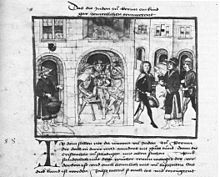
Murder of Rudolf of Bern, Bern Chronicle by Diebold Schilling the Elder.
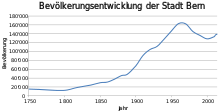
Population development1750 to 2014

Age pyramid of the population (2007)

The Evangelical Reformed Church of the Holy Spirit in Bern
Politics
An article in the NZZ described Bern in 2019 as "the most left-wing major city in Switzerland". The reason for this, it said, was sociostructural change, with a difference between city and agglomeration. After major Swiss cities had developed into social hotspots in the early 1990s, an increased influx of well-educated, affluent and young people had broken the negative spiral, and the cities were once again attractive as places to live.
Municipal Council
The municipal council of the city of Bern comprises five members who are elected every four years by the voters of the municipality of Bern. Unlike other Swiss executives, the Bern Municipal Council is elected according to the proportional representation principle. The last election took place on November 29, 2020.
The municipal council meets weekly at the Erlacherhof. Each member heads one of the city's five directorates. The City President chairs the meetings of the Municipal Council.
| Composition of the municipal council, legislative period 2021-2024 | |||
| Name | since | Party | Directorate |
| Alec von Graffenried | 2017 | GFL | City President, Presidential Office |
| Reto Nause | 2009 | The center | Vice-City President, Directorate for Security, Environment and Energy |
| Franziska Teuscher | 2013 | GB | Directorate for Education, Social Affairs and Sport |
| Marieke Kruit | 2021 | SP | Directorate for Civil Engineering, Transport and Urban Greening |
| Michael Aebersold | 2017 | SP | Directorate for Finance, Human Resources and Information Technology |
City Presidium
The listing of Bern's city presidents from 1832 onward can be found in the article List of Bern's City Presidents. The historical composition of the Bern Municipal Council can be found in the article Municipal Council (Bern).
A member of the Municipal Council is elected by direct vote of the electorate as President of the City. He presides over the Presidential Directorate and chairs the meetings of the Municipal Council. In addition, he represents the city externally. Alec von Graffenried of the GFL has been Bern's city president since 2017.
City Council
The legislature, the city council, has 80 deputies who, like the municipal council, are elected by proportional representation every four years, the last time in November 2020. In the current legislative period, 16 different lists are represented in the city council. Left-wing and center-left parties together form a clear majority.
The strongest party is the Social Democrats with 21 seats, followed by the left-wing Green Alliance with ten and the Green Liberals with nine. SVP, FDP and Grüne Freie Liste (GFL) each have seven seats, Die Mitte four (two each from BDP and CVP). Junge Alternative JA! and Alternative Linke each have three seats, EVP, JUSO and the Young Green Liberals two each. The Radical Green Alternative Party, the Communist Party of Labor and the Young Freisinnige are each represented by one person. The adjacent chart shows the distribution of seats in the city council after the election of November 29, 2020. 55 women and 25 men were elected, resulting in a record high share of women of 68.75%.
The City Council meets in Bern City Hall, every second Thursday evening. The meetings are open to the public.
Election results of the city council elections since 1897 can be found in the article Results of the municipal elections in Bern
National elections
The voter shares of the parties on the occasion of the 2019 National Council elections were:
| SP | GPS | glp | SVP | FDP | BDP | EVP | CVP | YES! | PdA | Pirates | EDU* |
| 28,7 % | 25,3 % | 13,5 % | 9,4 % | 7,6 % | 4,2 % | 2,5 % | 2,1 % | 2,1 % | 1,2 % | 0,9 % | 0,7 % |
* incl. DM
Town twinning
Unlike many other cities, the city of Bern does not engage in twinning. One exception was the temporary twinning arrangement that Bern entered into with Salzburg and the three Swiss host cities of Basel, Geneva and Zurich on the occasion of the 2008 European Football Championship. In its response to an interpellation by the SP parliamentary group in the city council, the municipal council stated in October 2008 that "the city of Bern has [so far] deliberately refrained from entering into a city partnership. This position was first formulated by the municipal council in 1979 in connection with a postulate [...] proposing town twinning for Bern. Since then, the municipal council has stuck to this strategy and rejected all requests for town twinning. The city of Bern actively maintains relations with a wide variety of cities. These relations are mostly organization-related [...] or topic- or project-specific [...]. The municipal council is prepared to examine whether one or more town twinning arrangements should additionally be entered into."
Bern is also one of the Zähringer cities.
Coat of arms
→ Main article: Flag and coat of arms of the canton and city of Bern
The bear as a heraldic animal of Bern is already documented for the 13th century. According to the Justinger Chronicle, Bern's first coat of arms is said to have shown a black bear striding upwards to the heraldic right on a silver background. The change to today's coat of arms probably already took place at the end of the 13th century.
When the city and canton of Bern separated in 1831, the Bern coat of arms became the coat of arms of both the canton and the city of Bern; since 1944 it has been the coat of arms of the Bern district. The blazon reads, "In red a golden right slanting bar, topped with a striding black bear with red claws."
The coat of arms and the verbal brand "City of Bern" together form the city brand. The following applies to all departments of the city administration: The city coat of arms never appears alone. It is always used together with the word mark "City of Bern".
The Bern coat of arms is also the coat of arms of the city of New Bern in North Carolina. One difference, however, is that New Bern's version lacks the red bear penis.

Coat of arms of the canton and city of Bern
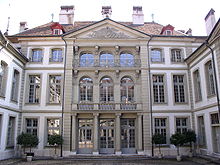
The Erlacherhof, seat of the government of the city of Berne
Culture
See also: List of cultural assets in Bern
Cinemas
There are numerous cinemas in Bern. In addition to commercially operating houses, there are various art house cinemas. The Kino Rex shows monthly retrospectives on international personalities and premieres of so-called independent productions. In the Old Town you can find the Kellerkino, which cooperates with Kino Rex and later includes the premieres shown there in its program. The Lichtspiel / Kinemathek combines a kind of museum with a cinema and a cinematheque.
With just under 33,000 visitors, the US survival adventure "The Revenant" was the biggest box office success of 2016 in the city of Bern. The second most successful animated film, "The Secret Life of Pets", attracted almost 28,000 visitors to Bern's movie theaters. "Zootropolis" (also "Zootopia", "Zoomania"), an animated film from Disney, was the third most-attended film in Bern's cinemas.
Museums and galleries
Bern has many museums spread throughout the city. In the center on Hodlerstrasse is the Art Museum, opened in 1879, the oldest art museum in Switzerland, with a permanent collection that houses works from eight centuries. In the immediate vicinity is the "Progr", Bern's first grammar school and later progymnasium, which today serves as a venue for exhibitions and events.
In Kirchenfeld near Helvetiaplatz are the Historical Museum, originally planned as the National Museum, which shows temporary exhibitions in addition to its collection and established the Einstein Museum in 2005, the Swiss Alpine Museum and the Kunsthalle, which shows several solo and group exhibitions devoted to contemporary art each year. Not far away are the Museum of Communication and the Natural History Museum, belonging to the Burgergemeinde, with its diorama show.
Located far outside the city center on the A6 highway, the Paul Klee Center, designed by Renzo Piano and opened in June 2005, boasts one of the largest collections dedicated to a single artist, with some 4,000 works by Paul Klee, a painter closely associated with Bern.
The majority of the numerous art galleries are located in the old town. With the Kornfeld Gallery, Bern has an auction house for Swiss and international art.
Also in the old town, at Kramgasse 49, is the Einstein House. A museum has been set up in the second-floor apartment that Albert Einstein and his first wife Mileva Marić occupied from 1903 to 1905, the annus mirabilis.
Theater
The Stadttheater Bern is an ensemble theater subsidized by the canton, the city and the surrounding municipalities, offering performances in all three divisions, drama, music theater and ballet. Since 2007, the Theater am Kornhausplatz has a second venue in a disused factory, the Vidmarhallen in Bern-Liebefeld.
The Theater an der Effingerstrasse is a chamber theater that puts on about 200 performances a year. Since 1998, the former Schlachthof has been home to the Schlachthaus Theater Bern, a guest performance theater subsidized with public funds for the independent theater scene in Switzerland. The former Dampfzentrale in Marzili is a cultural center for contemporary dance and music. The Reitschule also has a theater, the Theater Tojo.
There are several small theaters and cellar theaters in the old town, including the Bernese Puppet Theater, and Bern also has a boulevard theater in the form of the Theater am Käfigturm.
Music
Founded in 1877, the Bern Symphony Orchestra is the city orchestra of Bern. The orchestra, which performs both as a symphony orchestra in the Kultur Casino and as an opera orchestra in the city theater, is made up of around 100 musicians. Smaller in size is the Bern Chamber Orchestra, which focuses on older and more recent classical music and performs at various venues in the city. The Camerata Bern, consisting of 14 trained soloists, is one of Europe's leading chamber orchestras; the Bernese quintet I Salonisti, which has been in existence since 1981, achieved world fame with its performance as the on-board orchestra in the film Titanic.
Jazz is well represented in Bern. The hotel Innere Enge is home to the jazz club "Marians Jazzroom", the "Mahogany Hall" has existed since 1968, and the association BeJazz has had a club venue in the Vidmarhallen since 2007.
Bern is known for its dialect rock, which goes back to the Bernese-German chansons of the 1960s (by Mani Matter, among others). Well-known Bernese rock musicians and bands are or were Polo Hofer, Patent Ochsner, Span, Gölä, Stephan Eicher and Züri West. The singer-songwriter Roland Zoss can also be assigned to this scene.
In addition, there are a large number of choirs in the city of Bern with various repertoires from folk to classical; known far beyond the city limits is, for example, the Bern Chamber Choir or the Bern Kantorei.
Cultural Centers
The city of Bern has, among others, the alternative cultural center Reithalle, the Dampfzentrale Bern (cultural center for contemporary dance and music) and the youth center Gaskessel.
Zoo
In Bern there is the zoo Dählhölzli with the branch BärenPark at the Bärengraben, where three brown bears currently live in a large outdoor area as heraldic animals of Bern.
Festivals
The most famous festival is the Gurtenfestival, which takes place in July on the Gurten. The festival, which features international music stars, is attended by tens of thousands and is one of the largest in Switzerland.
Also in summer there is the Buskers street music festival and a free outdoor festival of BeJazz in the old town. In autumn, the shnit International Shortfilmfestival (shnit International Shortfilm Festival) is held, in late autumn the lesbian-gay film festival "Queersicht" and alternating with the music festival the Biennale Bern. In winter, the BeJazz association organizes a jazz festival. In spring, the International Jazz Festival Bern, the Swiss theater festival for contemporary theater "Aua wir leben", every two years the Music Festival Bern as well as the SonOhr Hörfestival take place.
Folk festivals
Every year on the fourth Monday in November, the "Zibelemärit" takes place in Bern; traditionally, mainly onions are sold at this market, around 30 tons at more than 600 market stalls. With visitors arriving early in the morning and a boisterous atmosphere created by confetti and plastic hammers with which children hit adults on the head, the Zibelemärit takes on the character of a folk festival. The Zibelemärit is one of the oldest fairs in Switzerland and the largest market in Bern.
Since 1957, the Bern "Granium-Märit" (Geranium Market) has been held on a Wednesday after the Ice Saints. In 1982, a total of 19,949 geraniums were sold. In 1984, the city of Bern was voted "Europe's most beautiful flower city" by the European competition Entente Florale Europe. Since 1997, a "Geranium King" has been elected at the Bern Geranium Market as part of the "Bern in Flowers" competition.
Other markets in Bern include the "Bäremärit" (Bear Market), the vegetable, fruit and flower market that takes place every Tuesday and Saturday on the Bundesplatz, among others, and the Christmas market.
Since 1982, the third largest carnival in Switzerland has been held in the spring in Bern's old town with over 50,000 visitors. The Bern Carnival kick-off begins on November 11 at 11:11 a.m. on Bärenplatz. At this time, the Bernese "Fasnachtsbär" is locked up in the Käfigturm for its winter hibernation. This event is accompanied by various Guggenmusik from the city of Bern and the surrounding area. About three months later, on the Thursday after Ash Wednesday, the Bern Carnival is opened at the Käfigturm with the release of the bear and the subsequent "Ychüblete" (drumming). The carnival bear is awakened and freed from its cage.
From 1996 to 2005, the Aareleuchten festival, organized by the Swiss aid organization Swissaid, was held on the Swiss federal holiday. Following the example of Hindu and Buddhist light and water festivals, little ships of light were placed in the Aare in the Matte district later in the evening and moved downstream in a chain of lights. After Swissaid held this event for the last time in 2005, an annual "Sea of Lights on Land" is now held on August 1 on the Waisenhausplatz, organized by Procap, the largest Swiss self-help organization of people with disabilities. Until 2019, the city of Bern's August 1 fireworks display was set off on the Gurten.
Every September, the "Sichlete" takes place in the middle of Bern on the Bundesplatz. This event, which has been held since 1999, is a kind of harvest festival with an alpine procession and an animal show that is intended to give the urban population an understanding of the life of the country people.
Sights
See also: List of sights of the city of Bern
Bern's main attraction is its Old Town, which has been a UNESCO World Heritage Site since 1983. UNESCO justified Bern's inclusion on the World Heritage List by stating that, notwithstanding the changes the city has undergone since its founding in the 12th century, Bern "represents a positive example of how a city can retain its medieval structure and adapt to the increasingly complex functions it is called upon to perform, in particular the tasks of a capital of a modern state."
The character of the old town is best preserved in the area below the Zytglogge; above it there are only a few buildings older than 150 years. The old town is characterized by its sandstone buildings with their arcades, which stretch for a good six kilometers and form one of the longest covered shopping streets in Europe. A baroque gem is the town hall on the Outer Stand. On Junkernstrasse is the residence of Béatrice von Wattenwyl and the former Federal Topographical Survey with the address Hallwylstrasse 4
There are over 100 fountains in the city of Bern. Typical are the eleven figure fountains from the 16th century, which are located on the regularly arranged alleys. The city stream, formerly an open sewer, also currently connects the fountains above and below ground. In the basement of the State Chancellery is the Lenbrunnen, the oldest cistern in Bern. The Oppenheim Fountain, designed by Meret Oppenheim, has stood on Waisenhausplatz since 1983.
The Nydegghof with the Gothic Nydegg Church, which has been rebuilt several times, the Zähringer Monument and the remains of the castle are located on the site where Nydegg Castle probably stood before the town was founded. The Nydeggstalden was built after the town fire of 1405; the interior of many houses has preserved building fabric dating back to the late Middle Ages, which is still visible on the outside of some houses.
On the flank of the Old Town at the height of the Käfigturm is the Bundesplatz with the Federal Houses and the Parliament Building, the headquarters of the Bernese Cantonal Bank in a neo-Renaissance building built as a society house, the neo-Baroque Swiss National Bank, the new Bollwerk Post Office and the Savings and Loan Bank, today Valiant Bank. In front of the Bundeshaus is the Bundesterrasse and the Kleine Schanze, still recognizable as a former fortification.
The Untertorbrücke, one of the oldest late medieval bridges in Switzerland, connects the city with the so-called Felsenburg, a 13th century fortified tower converted into apartments. On the Läuferplatz square stands the Läuferbrunnen fountain.
The town hall square with the Venner fountain is dominated by the late Gothic town hall rebuilt after the town fire between 1406 and 1417. In the immediate vicinity stands the neo-Gothic Christian Catholic Church of St. Peter and Paul from the 19th century.
Münsterplatz is dominated by the late Gothic cathedral, which, after the foundation stone was laid in the early 15th century, could only be completed with the tower superstructures in the late 19th century. Both the collegiate building of the canons' monastery and the Tscharnerhaus were planned by Albrecht Stürler. The Moses Fountain also dates from the 18th century.
The rest of the city of Bern was mostly settled from the 19th century. The newer quarters are connected with the old town by elevated bridges.
At the end of the Nydegg Bridge is the Bear Pit. Bears, the symbolic animals of Bern, were kept here from 1858 to 2009. A new, larger bear park was opened in October 2009. Above is the Rose Garden with excellent views of the old town. Also worth mentioning is the Bruder Klaus church on Segantinistrasse.
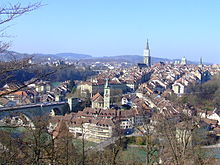
Bern old town

Kindlifresser fountain
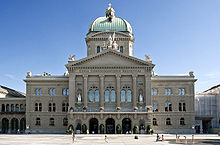
Bundeshaus and Bundesplatz after the redesign
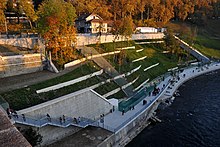
Bear Park
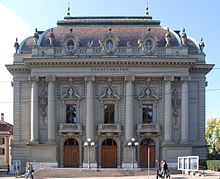
City Theater Bern
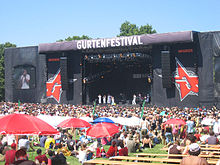
Main stage of the Gurtenfestival
.JPG)
Altstadtgasse in the direction of Zytglogge
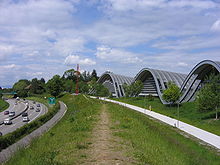
Paul Klee Center, Architect: Renzo Piano
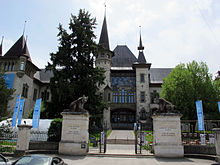
Historical Museum
Sports
Sports facilities
The Wankdorf stadium stood in Bern for over 50 years. It was named after the Bernese district in which it was located. It was built in 1920, after the old Spitalacker square was too small for the stands. At that time, the Wankdorf could fit just about 11,000 people. Over the years, the stadium was expanded again and again; at peak times, it offered more than 60,000 seats. The old Wankdorf was known beyond the country's borders, especially through the so-called Miracle of Bern. At that time, the final of the 1954 World Cup was held in the Wankdorf, which Germany won against the favored Hungarians. This victory is sometimes called the "birth of the Federal Republic of Germany". The stadium remained almost 50 years, only the capacity was reduced again. In 2001, the old Wankdorf was blown up and rebuilt as the Stade de Suisse, which has also borne the traditional name since 2020. It offers space for 31,783 spectators and is thus the second largest football stadium in Switzerland. The construction cost around 350 million Swiss francs.
With currently 17,031 seats, the PostFinance Arena is the largest ice sports arena in Switzerland and one of the largest in Europe. It was built in 1967 and roofed over in 1969. Particularly characteristic is its huge standing room ramp with a capacity of 10,331 seats - the largest in the world in an ice hockey stadium.
The city of Bern has several indoor and outdoor swimming pools. The oldest indoor swimming pool is located in the city center at Hirschengraben. It was built at the beginning of the 20th century. The most famous outdoor pool is the Marzilibad on the Aare River, another Aare River pool is in the Lorraine. Popular are the Weyermannshaus bath and the Ka-We-De wave pool, which become ice rinks in winter. In contrast to most other Swiss cities, the public outdoor swimming pools in the city of Bern are free of charge, with a few exceptions.
Sports clubs
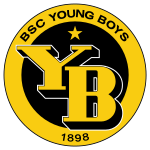
The football club BSC Young Boys plays in the Raiffeisen Super League, the highest Swiss league. It has been Swiss champion fifteen times, most recently in 2021, and Swiss Cup winner 7 times, most recently in 2020. Young Boys' U21 team plays in the 1st division. The slightly older city club and traditional club FC Bern was successful at the beginning of the last century.
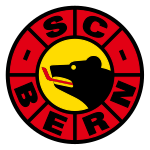
The city of Bern's ice hockey club SC Bern plays in Switzerland's top ice hockey league, the National League A, and has been Swiss champion sixteen times since 1959, most recently in the 2018/19 season. Across Europe, SCB has the highest average attendance at home games.
BSV Bern Muri was founded in 1951 as TV Oberseminar and is today one of the biggest handball clubs in Switzerland. It has been champion in the National League A three times, the last time in 1985. Currently the club plays in the highest national division.
The Stadtturnverein Bern was founded in 1873 and is one of the largest gymnastics clubs in Switzerland with around 2000 members. The STB is best known for its member club STBern Leichtathletik. STBern Leichtathletik is the largest and one of the most successful athletics clubs in Switzerland. In less noticed sports, especially the American football club Bern Grizzlies and the baseball and softball club Bern Cardinals have some international successes. The Rolling Thunder Bern are 7-time Swiss champions in powerchair field hockey. They have been playing in the top league continuously since the foundation of the National League in 2013.
Sports events
Bern was one of six venues for the 1954 World Cup and one of eight venues for the 2008 European Football Championships. Bern was also the venue for the 1971, 1990 and 2009 World Ice Hockey Championships and was chosen to host the 2011 European Figure Skating Championships.
Every year, the Grand Prix of Bern, Switzerland's largest mass sports event, takes place in Bern. More than 25,000 runners from Switzerland and abroad regularly take part in this running event. The original course runs partly through the historic old town and along the Aare river.
The Swiss Women's Run, also held in Bern, is open to women only and, with nearly 13,000 participants, is the largest women's run in Europe and the biggest women's sports event in Switzerland. The 5-kilometer main race also attracts elite female runners as part of the Post Cup. Since 2005, there has also been a 10-kilometer course. There is also a 15-kilometer course for walking and Nordic walking. The Women's Run has been running through the center of Bern since 2005 and ends on the Bundesplatz.
Today, the "Bern Open" is the best-staffed curling tournament in Europe and is considered one of the most important tournaments in international curling outside the curling stronghold of Canada.
The Bremgarten circuit was located in the Bremgarten forest, where motor sports events were held from 1931 to 1955.
The Weissenbühl hosted the Swiss Amateur Beach Volleyball Championships in 2009 and 2011.
The Bern E-Prix was an automobile race of the FIA Formula E Championship and was held on June 22, 2019 as part of the 2018/19 FIA Formula E Championship.
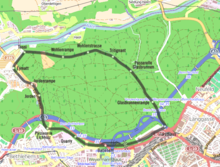
Circuit in the Bremgarten forest
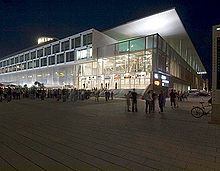
The Wankdorf Stadium from the outside
See also
![]()
Portal: Bern - Overview of Wikipedia content about Bern
![]() Files: Bern - local collection of images and media files
Files: Bern - local collection of images and media files
- City of Bern districts
- List of cultural assets in Bern
- List of sights of the city of Bern
- Flag and coat of arms of the canton and city of Bern
- List of personalities of the canton of Bern
- Burgergemeinde Bern
Search within the encyclopedia